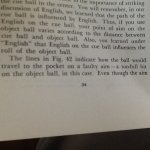I believe on page 53 he is only showing how you can find the CP by aiming through CCB.
On pages 54 & 55 he then explains how CCB aiming to OB contact point is too thick a hit.
View attachment 515961
He does not mention anything like this. The image you posted is not showing how ccb to cp causes a thick hit. He is showing how the margin for error changes as the ob gets farther from the pocket. The image illustrates how the same faulty aim causes worse results when the ob is farther out. As far as aiming, he specifically says to aim ccb to the ob contact point. He calls the contact point the "point of aim."
Other than the misleading info on aiming, it's a good book.
Last edited:
